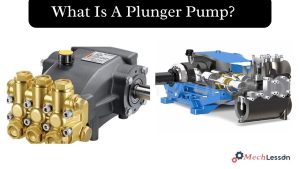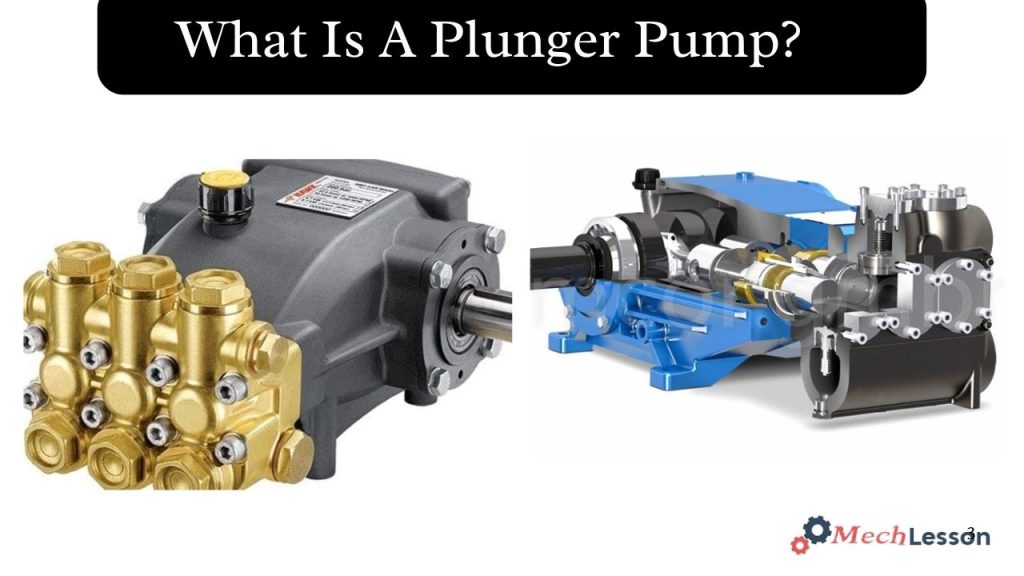Plunger pumps are mechanical devices that transform mechanical energy into fluid energy and are utilized in many different industrial areas.
Emiltec’s plunger pumps are well-liked in applications including high-pressure washing, pipe unclogging, reverse osmosis, misting, and fire prevention since they are made especially to pump high-pressure water.
The kind of pump your pressure washer uses determines how it works. Plunger pumps and piston pumps are the two primary varieties of pressure washer pumps. You can choose the best pressure washer model for you by being aware of the similarities and differences between the two.
In this article, we will explore what a plunger pump is, it’s application, diagram, types, differences, and how it works. We also discussed its advantages and disadvantages
Let’s drive in!
Learn about Submersible Pump with this detailed guide!
What is a plunger pump?
A smooth cylindrical plunger passes through a fixed high-pressure seal in a plunger pump, a form of positive displacement pump. They may be utilized at greater pressures because of this, which sets them apart from piston pumps. Wastewater from industries and municipalities is frequently pumped using this kind of pump.
Fluid is forced through a number of valves by a reciprocating plunger that goes back and forth in piston pumps, also known as piston pumps. A bicycle pump, a spray bottle, or a squirt gun are a few basic examples from our daily lives.
In commercial settings, plunger pumps are frequently utilized in electrically driven devices including pressure washers, atomizers, and sprayers for cleaning, disinfection, pest control, and agricultural purposes. According to a 1675 patent, Samuel Morland is credited with creating the plunger pump.
Application of a plunger pump
High pressure may be delivered by the plunger pumps. Heavy materials and highly viscous fluids can be pumped by these pumps. Plunger pumps are utilised in the following applications as a result of these characteristics:
- These pumps are used for injecting chemicals.
- These pumps are also used for misting and odour control.
- A plunger pump is used for injection in drill cutting.
- For water cutting
- Utilisation in the production of gas and oil
- Gas dehydration is another usage for plunger pumps.
- They are employed for surface preparation.
- Plunger pumps are also used to produce urea.
- They are employed in cleaning applications.
- These pumps are used to liquefy coal.
- These are employed in pressure testing.
Learn about Screw Pump with this detailed guide!
DIagram

Differences between plunger pumps and piston pumps
Piston pumps and plunger pumps function similarly. Water is drawn through a one-way intake valve, pressurised, and released through a one-way outtake valve using these reciprocating displacement pumps.
Two (duplex) or three (triplex) pistons or plungers are found in the majority of pressure washer machines. For duplex pumps to achieve the same flow rate as triplex pumps, they must work harder and quicker. As a result, duplex pumps often wear out faster.
Learn about Gear Pump with this detailed guide!
Types of plunger pump
the various types of plunger pumps, including:
- Plunger
- Cylinder Inlet value
- outlet live
- inlet value
- Seal
How does plunger pump works
Plunge pumps and piston pumps are reciprocating pumps that transfer media through a cylindrical cylinder using a plunger or piston. An electric, hydraulic, pneumatic, or steam-powered actuator controls the plunger or piston.
In order to drive gas or liquid through the pump, rotary piston and plunger pumps employ a crank mechanism to produce a reciprocating motion along an axis. This creates pressure in a cylinder or power cylinder. Both the suction and discharge valves are controlled by the pressure inside the chamber.
Applications for piston pumps can vary from 70 to 2,070 bar (1,000 to 30,000 psi). Applications requiring low pressure are served by piston pumps. The area of the plunger or piston multiplied by the stroke length equals the volume of fluid released.
The area of the piston or plunger, the stroke length, the number of pistons or plungers, and the driving speed may all be used to determine the overall performance of piston and plunger pumps.
The drive’s power needs are directly correlated with the pump’s capacity and pressure. In order to isolate the driving fluid from the fluid being handled, seals are a crucial component of plunger and piston pumps.
The connection between the plunger or piston and the container in which the medium is being transported is sealed by a gland or packing. Stuffing boxes, packing or sealing rings, and bushings can all be included in a stuffing box.
Plunger pump components are chosen based on their durability and compatibility with various media types. Bronze, brass, steel, stainless steel, iron, nickel alloy, and other materials are examples of component materials.
For instance, an iron cylinder and plunger are frequently seen in plunger pumps used in general service or oil service applications. The material choice is determined by the liquid being moved, and the piston, discharge valves, and suction valves all come into touch with the medium.
All-ceramic plungers can be utilised in performance applications that call for continuous duty plunger pumps when they come into contact with water and oil, but they might not be appropriate for use with extremely acidic media types.
Learn about Hand Pump with this detailed guide!
Advantages of plunger pump
Plunger pump benefits
- It is very efficient and capable of self-priming (self-priming pump).
- It is possible to have extremely high developed/discharge pressure.
- Controlling capacity linearly while utilising variable speed
- If your employer allows you to tighten the packing while the pump is operating, you can reduce the leak without turning it off.
- Compared to piston pumps, they may provide higher pressure.
- Changes in pressure and flow rate have virtually little effect on the plunger pump’s operation.
- These are capable of pumping slurries and abrasives.
- They are capable of transporting heavy and viscous materials.
Disadvantages of plunger pump
The drawbacks of the plunger pump
- extremely low flow in contrast to an axial or centrifugal pump
- Pulsation is caused by irregular flow.
- High vibration due to reciprocating action, even if the rotational speed is often lower than dynamic pumps, and prone to cavitation due to acceleration head, particularly if the suction pipe is lengthy
- The expense of operating these pumps is significant.
- This pump requires expensive upkeep.
- Pulsating free flow is not possible with plunger pumps.
- Only fluids with modest flow rates can be handled by these pumps.
- They are hefty and unwieldy.
Learn about Centrifugal Pump with this detailed guide!
FAQs
What is a plunger pump used for?
Soft wash, portable sanitation, disinfection, pest control, agricultural, and other high-pressure applications are among the commercial uses for plunger pumps. They can be set up to operate electrically powered devices, including sprayers, misters, and pressure washers.
What are the disadvantages of a plunger pump?
The self-priming capability and high efficiency of piston and plunger pumps are their advantages; however, their pulsating delivery, space requirements, large mass, and high investment costs per unit of pump output are their disadvantages, particularly when it comes to large units.
What is the difference between a plunger pump and a piston pump?
A plunger fits loosely inside the cylinder as opposed to a piston, which fits securely. As it rises and falls, the plunger generates both positive and negative water pressure inside the cylinder.
What is the advantage of the plunger pump over the piston pump?
Compared to piston pumps, plunger pumps require far less maintenance, have fewer components, and a more straightforward design.
What is the purpose of a plunger?
The term “plunger” in plumbing often refers to portable instruments used to unclog pipelines and drains. A rubber suction cup is fastened to a stick, or shaft, that is often composed of plastic or wood in plumbing plungers.
What is the maximum pressure for a plunger pump?
A plunger pump’s maximum pressure is the highest pressure it can produce without degrading its functionality or causing damage to its constituent parts. Depending on how the pump is built and designed, the machine’s maximum pressure usually falls between 1000 and 5000 psi (pounds per square inch).

